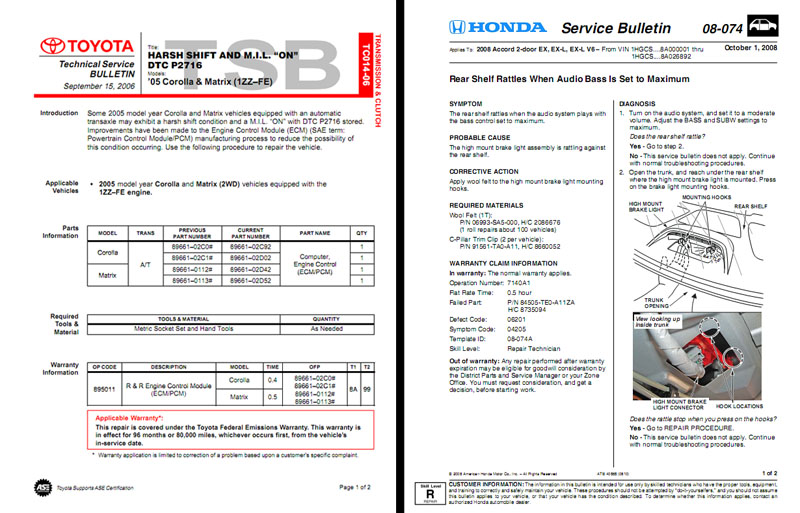Obscure Maintenance: Secret Warranties

The complexity of modern cars is becoming a conundrum for manufacturers. Often, the factory support team sees recurring problems that are hard to diagnose but easy to fix. Dealer technicians hate this because they only get paid a fixed rate for performing a repair. Both the dealership and the technician are paid nothing by headquarters for diagnosing warranty repairs. How, then, does a corporation like Ford ensure that their warranties are being honored by their dealers, when nobody is paid to diagnose a problem?
The answer is service bulletins, either as a standalone alert or in a newsletter. There are different names for bulletins, but some companies refer to them as Technical Service Bulletins (TSB). TSB’s save technicians a lot of time by alerting them to common issues that might otherwise be initially misdiagnosed. However, they can also save a consumer money. Large carmakers are always worried about customer loyalty, and are often willing to fix problems after the warranty ends to make people happy (especially Japanese automakers). Hence, TSB’s are sometimes known as the “Secret Warranty.” They’re not guaranteed to get your vehicle fixed, and results often vary from dealer to dealer, but it’s worth a shot.
Why a TSB and not a recall?
The first thing to understand is that recalls are only for safety related issues that are likely to cause accidents, injury, or death. TSB’s are more often for small issues that aren’t harmful – random annoying noises, faulty parts that won’t cause accidents, etc. There’s no need to worry if your vehicle has hundreds of TSB’s – most of them won’t affect your vehicle. While bulletins are for “common” issues, that can mean anything from tens of vehicles to hundreds of thousands of vehicles. Just because there is a TSB doesn’t mean that there is a need to be constantly looking for the issue. Remember that many cars are made in multiple countries – Japan, Mexico, USA, Canada, etc. Bulletins can cover a faulty part or process from only one of those plants, when the others were fine.
How to use a TSB
If the vehicle in question seems to exhibit symptoms described in the TSB, then it must be brought to a certified dealer’s service department. Only dealers get TSB updates and can address these issues for free, due to their factory/corporate technical support. Neighborhood mechanics cannot fix the issue for free, and usually won’t have knowledge of the TSB.
Upon arriving at your dealer’s service department, it’s important to mention the issue and any relevant details to see what the service advisor says. If the service advisor seems to have no clue what the problem is, mention that there may have been a TSB (give a reference number, if possible) before signing any paperwork or agreeing to pay for anything. This method gives the service advisor a chance to show their knowledge, so they feel better and are more likely to help.
Usually, a service advisor won’t be able to give a straight answer right away. Getting approval to do a warranty repair when the vehicle is out of warranty is called a “goodwill” repair, and requires calling a few people higher up the food chain. The vehicle manufacturer is going to pay for this repair, so it is their call whether to do it or not. If the service advisor says the repair can’t be done for free, it’s not their fault!
The Risks
There are many variables to getting a repair fixed for free out of warranty. Different dealers and service advisors may have different contacts at the corporation, so the chances of a free fix will vary. It also depends on how far out of warranty the vehicle is, and whether it is out of warranty by mileage or by years. Toyota may be more willing to repair a vehicle that is 6 years old with 35,000 miles, rather than a car that’s 2 years old with 80,000 miles (standard warranty: 3 years or 36,000 miles, whichever comes first). Or it could be vice versa. It depends on the issue and your luck.
Many dealers also require a diagnostic fee to even look at any issues. It is up to the consumer whether they agree to this. If corporate pays for the repair, the diagnostic fee is waived. If the diagnosis comes back negative for the TSB’s issue, or if corporate refuses to perform the repair, the consumer still has to pay the diagnostic fee. This issue is up to personal discretion – if the consumer was going to repair the issue regardless of how much it cost, then the fee is worth a shot. The fee can be applied towards any not-free repairs made as a result of the diagnosis anyway. However, if it’s a minor issue, it’s better to walk away and write off the lost time.

